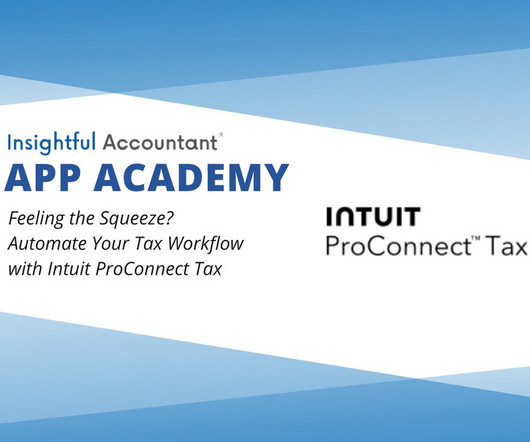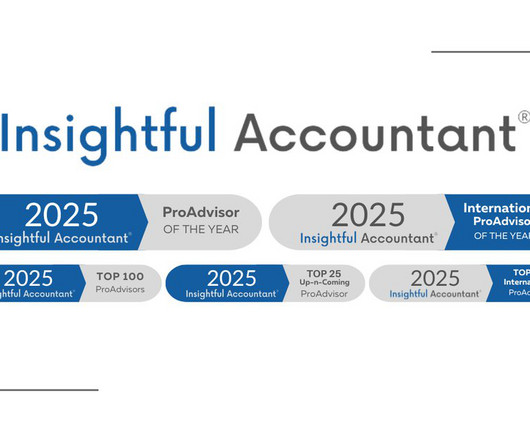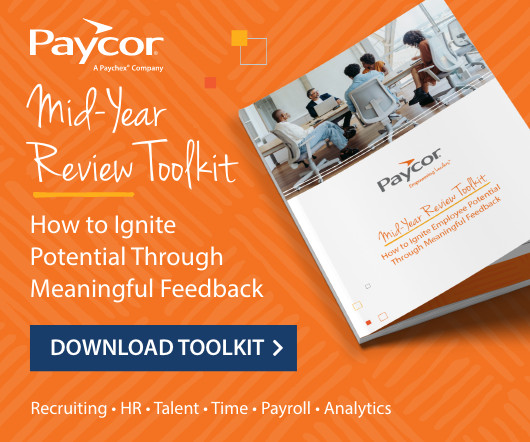IRS crypto enforcement could get tougher
Accounting Today
JULY 15, 2024
The Internal Revenue Service could be doing a better job of cracking down on tax noncompliance by users of virtual currency or digital assets, according to a new report.

Accounting Today
JULY 15, 2024
The Internal Revenue Service could be doing a better job of cracking down on tax noncompliance by users of virtual currency or digital assets, according to a new report.

Billing Platform
JULY 15, 2024
Also referred to as yield management, revenue management can be described in extremely simplistic terms ( selling the right product, to the right customer, at the right price, through the right channel ) or defined in a more complex manner. Brought mainstream by industries like hospitality and airlines, revenue management is a discipline that combines data mining, analytics, and operations research to understand customer behavior.
This site is protected by reCAPTCHA and the Google Privacy Policy and Terms of Service apply.

Accounting Today
JULY 15, 2024
The IRS warned about bad advice that's being peddled on social media promoting a bogus "Self Employment Tax Credit" and prompting unsuspecting taxpayers to file false claims for the credit.

Nolan Accounting Center
JULY 15, 2024
As a small business owner, you should want to improve your business operations. Indeed, every business owner should recognize that improving operating efficiency must be an ongoing endeavor. As American editor and publisher Clarence W. Barron stated, “Everything can be improved.” More pointedly, Japanese consultant Masaaki Imai said, “Not a day should go by without some kind of improvement made somewhere in the company.

Speaker: Jason Chester, Director, Product Management
In today’s manufacturing landscape, staying competitive means moving beyond reactive quality checks and toward real-time, data-driven process control. But what does true manufacturing process optimization look like—and why is it more urgent now than ever? Join Jason Chester in this new, thought-provoking session on how modern manufacturers are rethinking quality operations from the ground up.

Accounting Today
JULY 15, 2024
CliftonLarsonAllen CEO Jen Leary has been focusing on expanding the firm's appeal, especially to young accountants, as CLA grows its international network.

Enterprise Recovery: Accounts Receivable
JULY 15, 2024
Retention marketing is the practice of implementing strategies and techniques to keep existing clients engaged and loyal to your business. While acquiring new customers is important, retaining existing ones is more valuable for the long-term success of your business. By focusing on client retention, you can build strong relationships, increase customer satisfaction, and ultimately drive revenue growth.
Financial Ops World brings together the best financial operations content from the widest variety of thought leaders.

Accounting Tools
JULY 15, 2024
What is Goods in Transit? Goods in transit refers to merchandise and other types of inventory that have left the shipping dock of the seller, but not yet reached the receiving dock of the buyer. The concept is used to indicate whether the buyer or seller of goods has taken possession, and who is paying for transport. Ideally, either the seller or the buyer should record goods in transit in its accounting records.

Accounting Today
JULY 15, 2024
Test your accounting knowledge on AI layoffs, the IRS Direct File program, and more. No. 2 pencil not required!

Accounting Tools
JULY 15, 2024
What are Taxation Principles? Taxation principles are the guidelines that a governing entity should use when devising a system of taxation. These principles include the following items: Broad application. The system of taxation should be spread across a broadest possible population, so that no one person or entity is taxed excessively. Instead, the entire population shares in the taxation burden.

Accounting Today
JULY 15, 2024
Wolters Kluwer announced CCH Tagetik Tax Provision & Reporting, a solution offering data collection and group tax provision calculations for multinationals.

Speaker: Gerald Ratigan
The accounts payable (AP) function is evolving and AI is leading the charge. As finance teams face rising invoice volumes and expectations for speed and accuracy, AI-powered automation has shifted from a futuristic concept to the most practical solution. But for finance leaders, success isn’t just about selecting the right tools, it’s about implementing the right strategy.

Accounting Tools
JULY 15, 2024
What is Profit Planning? Profit planning is the set of actions taken to achieve a targeted profit level. These actions involve the development of an interlocking set of budgets that roll up into a master budget. The management team adjusts the information in this set of budgets to arrive at the combination of actions needed to arrive at the targeted profit level.

Accounting Today
JULY 15, 2024
OneStream Inc. and a group of shareholders including KKR & Co. are seeking to raise $465.5 million in a U.S. initial public offering.

Accounting Tools
JULY 15, 2024
What is the Provision for Doubtful Debts? The provision for doubtful debts is the estimated amount of bad debt that will arise from accounts receivable that have been issued but not yet collected. It is identical to the allowance for doubtful accounts. The provision is used under accrual basis accounting , so that an expense is recognized for probable bad debts as soon as invoices are issued to customers , rather than waiting several months to find out exactly which invoices turned out to be unc

Accounting Today
JULY 15, 2024
The combination of variable prepaid forwards with long and short equity positions outpaces the after-tax returns of a direct indexing strategy, a new study found.

Speaker: Sean Yoder
Nonprofits are under more pressure than ever to demonstrate financial accountability while continuing to expand their impact. Traditional budgeting models often fall short, reinforcing silos, limiting flexibility, and stalling growth. Enter collaborative budgeting: a dynamic, team-driven process that enables smarter resource allocation and builds financial resilience at scale.

Accounting Tools
JULY 15, 2024
What are the Basics of Cost Accounting? Cost accounting is the art of translating the costs incurred by a business into actionable analyses that can improve operations and profits. Here are several basic ways in which to use cost accounting: Activity-based costing. This is a methodology for more precisely allocating overhead costs to products and services.

Insightful Accountant
JULY 15, 2024
If you missed our recent App Academy webinar, Intuit shared how to leverage ProConnect Tax solutions to streamline the workflow across Books-Income Tax-Advisory to enable you to automate compliance tasks.

Billing Platform
JULY 15, 2024
Also referred to as yield management, revenue management can be described in extremely simplistic terms ( selling the right product, to the right customer, at the right price, through the right channel ) or defined in a more complex manner. Brought mainstream by industries like hospitality and airlines, revenue management is a discipline that combines data mining, analytics, and operations research to understand customer behavior.

finout
JULY 15, 2024
As organizations increasingly shift to cloud computing, managing cloud costs emerges as a primary concern. The flexibility and scalability of platforms like Amazon Web Services (AWS) bring significant benefits but also introduce tremendous complexity in tracking and controlling expenses. The dynamic nature of cloud billing, with its myriad of services and pricing options, often leads to unexpected costs, making it challenging for organizations to stay within budget.

Speaker: Joe Wroblewski, Sales Engineer Manager
Automating time-consuming manual tasks can save your firm hundreds of hours–and thousands of dollars. But it can also have longer-lasting benefits, like helping you attract and retain the next generation of CPAs, and we don’t need to tell you how important that is amid the current generational staffing crisis in the tax and accounting profession. You'll want to save your seat for this new webinar with industry expert Joe Wroblewski, where we'll explore how to: Maximize ROI with Cost-Effective Te

Insightful Accountant
JULY 15, 2024
Why wait? Now is a perfect time to join the many ProAdvisors who have already started the 2025 ProAdvisor Awards process by nominating a fellow ProAdvisor, being nominated by a colleague or client, or applying.

Accounting Tools
JULY 15, 2024
What is the Doomsday Ratio? The doomsday ratio is the most conservative measure of the ability of a business to pay its short-term obligations. The name is derived from the assumption that, if a business were on the verge of bankruptcy , could it still pay its bills right now? The ratio is not actually used for that purpose, but rather to determine the adequacy of the amount of cash on hand.

Insightful Accountant
JULY 15, 2024
Janel Sykora, Kellie Parks and Christine Gervais kick of Insightful Accountant's Be Insightful membership program with CPE Webinars, Q&A sessions and actionable steps to grow your firm.

Accounting Tools
JULY 15, 2024
What is a Step Fixed Cost? A step fixed cost is a cost that does not change within certain high and low thresholds of activity, but which will change when these thresholds are breached. When the cost changes as a result of a threshold breach, a new set of high and low activity thresholds will then apply, within which the fixed cost will not change appreciably.

Advertisement
Automation generally supercharges any process and brings its value to the forefront. See how infusing automation such as ART (our month-end close solution), into your close can get you to the next level of closing. We will share a live demo of SkyStem's solution, ART and share the key elements of month-end close automation. Through ART, we'll take a look at: What month-end close automation entails Which process steps can and should be automated Benefits of achieving process automation, and Why i

Accounting Tools
JULY 15, 2024
What is the Bank Reconciliation Process? The bank reconciliation process involves comparing the internal and bank records for a bank account , and adjusting the internal records as necessary to bring the two into alignment. This is done to ensure that an organization’s recorded cash balance is accurate. The bank reconciliation process is usually accomplished with the bank reconciliation module in an accounting software package.

Accounting Tools
JULY 15, 2024
What is the Unit of Production Method? The unit of production method is a technique for charging capitalized costs to expense in the oil and gas industry, using the ratio of produced units to reserves. This is done by estimating the total number of units of proved oil or gas reserves and dividing actual production in the period by the beginning proved reserves to derive the amortization rate.

Accounting Tools
JULY 15, 2024
What is Wealth Maximization? Wealth maximization is the concept of increasing the value of a business in order to increase the value of the shares held by its stockholders. The concept requires a company's management team to continually search for the highest possible returns on funds invested in the business, while mitigating any associated risk of loss.

Accounting Tools
JULY 15, 2024
What is the Equity Method? The equity method of accounting is used to account for an organization’s investment in another entity (the investee). This method is only used when the investor has significant influence over the investee. Under this method, the investor recognizes its share of the profits and losses of the investee in the periods when these profits and losses are also reflected in the accounts of the investee.

Advertiser: Paycor
Mid-year performance reviews aren’t just boxes for HR to check. Paycor’s toolkit empowers leaders to: Identify high-potential team members. Boost engagement with meaningful feedback. Support struggling employees. Nurture top talent to drive results. Learn how to ignite employee potential through meaningful feedback. When you nurture top talent, everybody wins.

Accounting Tools
JULY 15, 2024
What is the Contribution Margin Ratio? The contribution margin ratio is the difference between a company's sales and variable expenses , expressed as a percentage. The total margin generated by an entity represents the total earnings available to pay for fixed expenses and generate a profit. When used on an individual unit sale, the ratio expresses the proportion of profit generated on that specific sale.

Accounting Tools
JULY 15, 2024
What is the Implicit Interest Rate? An implicit interest rate is an interest rate that is not specifically stated in a business transaction. Any accounting transaction that involves a stream of payments extending over multiple future periods must incorporate an interest rate, even if there is no rate stated in the related business contract. Otherwise, the contract does not reflect the expense associated with delaying payments over a period of time, which is known as interest expense.

Accounting Tools
JULY 15, 2024
What are Asset Recognition Criteria? Asset recognition criteria are needed to determine which assets will be included in the balance sheet. When an expenditure is made, it can either be recognized as an expense or an asset , with recognition as an expense being the default presumption. Most expenditures will be recognized at once as expenses, since they reflect the immediate consumption of the underlying expenditure.
Let's personalize your content